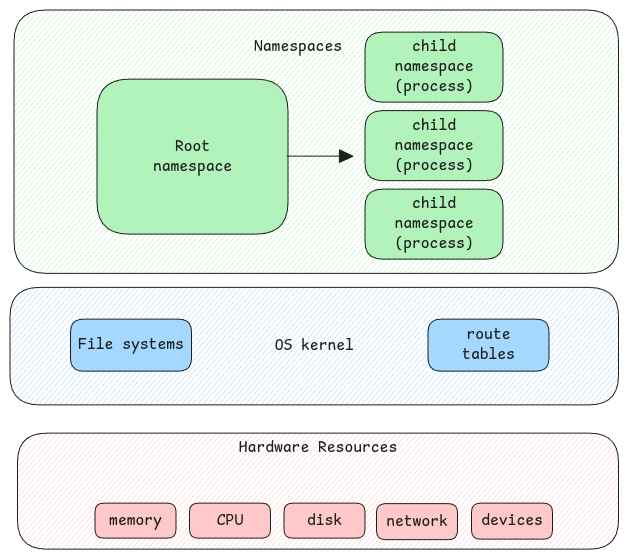Namespaces
Namespaces is a concept which provides process isolation. This means, the process which is started with its own namespace has its own set of users, resources, mount points and may more.
It's a kernel feature where kernel allows userspace applications to run on isolated environments.
This means, when a process is started, we can define the namespaces
- user namespace, mount namespace, network namespace, hostname namespace, time namespace, etc to be used by the namespace. The kernel ensures that the process sees a specific view of the underlying hardware.
Not all above mentioned namespaces are necessary when we create an isolated environment.
For example, if a process is started without a mount namespace, then the process sees the same filesystem that the parent process sees.
In case of docker, it automatically ensures the application process is created with all necessary namespaces to ensure complete isolation.

Even though Docker gives a feeling that applications are running on its individual machine, it's not true.
It's just another isolated environment to execute a process since the docker image doesn't have the kernel packaged into it.
nsproxy struct
As we know every process in Linux has a corresponding struct task_struct. See here.
This struct has a pointer to another structure called struct nsproxy. This structure has references to all namespaces objects of the process.
/proc Filesystem
All data about processes and its namespaces are stored in /proc/ filesystem where each namespace of the user has file to it.
Since every file has a inode number in Linux, the kernel holds a map of this inode number to the actual underlying namespace object of the process.
In case of docker, when a container is started, the Docker CLI reads the entrypoint from the Dockerfile, creates necessary namespaces and starts that application process in that namespace.
Standard Streams
When a docker container or when a process with an isolated namespace is started, the standard streams of these processes are set to the parent process that's executing the process that's why the output of the application is seen on the terminal which started the process.
cgroup
cgroup is short form of control groups. With cgroup, we can control the amount of physical resources